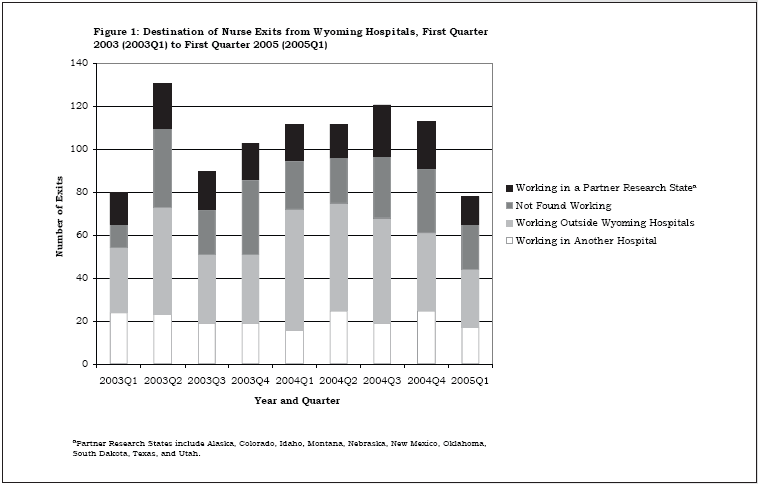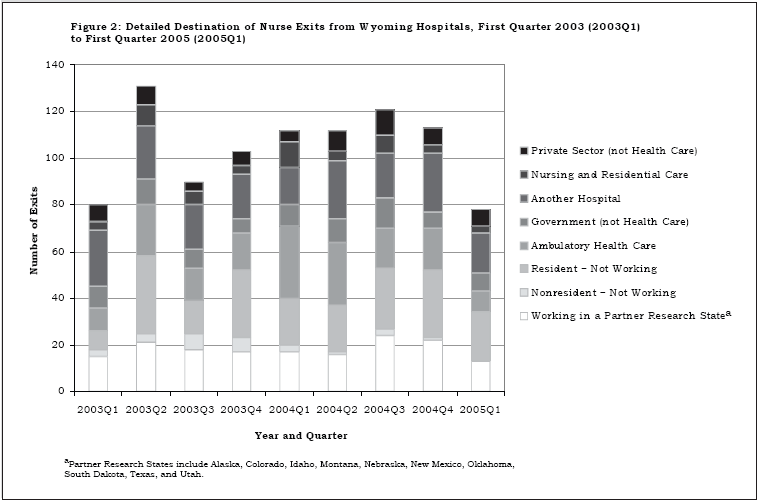© Copyright 2007 by the Wyoming Department of Employment, Research & Planning
Vol. 44 No. 6
Nurses may exit or terminate employment for a variety of reasons. For example, some may take jobs at other hospitals or elsewhere in the health care field. Some may decide to leave health care for other jobs, and others may retire or leave the workforce entirely. An examination of administrative data can provide clues as to why these decisions are made. Such an examination also can be repeated to spot trends and patterns within the nursing labor pool.
When nurses terminate or exit employment from a hospital, do they remain attached to the labor market? Do they continue working in Wyoming hospitals or leave hospitals for another industry? Distinct patterns in the destination locations (i.e., where exiting nurses subsequently work) may provide useful hints about the reasons for turnover. The approach presented here can be applied to any number of occupations and industries if administrative data, including a person's occupation at a given time, are made available to Research and Planning (R&P). The advantage of this approach is that it is relatively low-cost compared to conducting surveys. It does not require contact with nurses or their employers and can be repeated to watch patterns.
Method
The method for tracking nurses who exit from hospitals was developed previously (Glover, 2001; Harris, 2006). The work destination was limited to the four quarters subsequent to the quarter in which the nurse exited employment. In cases in which the worker had more than one employer in the period, work destination was defined as the employer who paid the highest wages. Data used for this study included:
Wyoming Wage Records (to identify persons and their employers)
Wyoming Quarterly Census of Employment and Wages (to identify employers' industries)
Wyoming Driver's License database provided by the Wyoming Department of Transportation (to determine worker age and gender)
Nursing Licensure database provided by the Wyoming Board of Nursing (to identify nurses).
This article is a subsection of a larger study being produced under contract with the Wyoming Health Care Commission.
Findings and Implications
Over a nine-quarter period from first quarter 2003 to first quarter 2005, approximately 20 nurses exited a Wyoming hospital each quarter but later worked in another Wyoming hospital (see Figure 1). Even though they left a specific hospital, hospitals were their preferred work destination. This represents a turnover cost to the hospital the nurse left, but does not constitute a loss of nursing skill from Wyoming hospitals in the aggregate. Reducing this type of turnover is likely an issue for the specific hospitals rather than a systemic or general labor market issue.
Between 20 and 40 nurses exited hospitals altogether each quarter but were later found working elsewhere in Wyoming. This situation represents a loss of nursing skill and labor to Wyoming hospitals but does not represent a loss for Wyoming's labor market. This type of turnover may be due to dissatisfaction with hospitals generally but does not represent a disengagement from Wyoming's labor market.
A fairly consistent number (10 to 15) of nurses exited from Wyoming hospitals each quarter who subsequently worked in one of the partner states with which Wyoming exchanges Wage Records data (Alaska, Colorado, Idaho, Montana, Nebraska, New Mexico, Oklahoma, South Dakota, Texas, and Utah). This situation represents a loss of nursing skill from Wyoming's entire labor market. This type of turnover may be closely tied to general economic conditions in Wyoming's labor market, such as wage differentials between states.
Ten to 20 nurses exited from Wyoming hospitals and could not be identified as subsequently working in R&P's administrative databases. Reaching conclusions about the nurses' decisions to exit employment is complex. Among other reasons, these nurses may have retired, become self-employed, gone to work in a state with which R&P does not share wage records, left the labor market for other personal or family reasons, or gone to work for an employer in Wyoming not covered by wage records, such as one of the two Veterans Administration hospitals. This situation represents a substantial loss of nursing labor to Wyoming hospitals each quarter.
Figure 2 was generated from the same data used for Figure 1 but provides additional destination information. A number of nurses who exited from a hospital but remained working in Wyoming chose to subsequently work in Ambulatory Health Care. Additionally, the majority of nurses not subsequently working were known Wyoming residents (Jones, 2004) during the quarter in which they exited.
Conclusions
The specific reasons why employees terminate or exit employment are varied and cannot be fully illustrated in a research approach using administrative records. However, the use of administrative data to describe the work destination of exiting nurses reveals useful underlying patterns. The historical pattern shows that many of the nurses who exited from a Wyoming hospital remained attached to Wyoming's labor market but did not obtain employment in another hospital. Efforts to understand why these nurses left employment in hospitals for other Wyoming work destinations may be fruitful.
Nurses who exit hospitals but continue working in Wyoming (the primary destination of exiting nurses) are a potential pool of nursing labor for hospitals in the state. They have the advantage of being currently licensed in Wyoming and are likely to already have housing in the state.
Note
The research method presented here is generic. R&P can track other occupations of interest if we obtain administrative records that identify persons in a given occupation by social security numbers. For further information about the possibilities for your organization, contact R&P at 307-473-3807.
References
Glover, W. (2001). Turnover analysis: Definitions, process, and quantifications. Retrieved June 22, 2007, from http://doe. state.wy.us/LMI/w_r_research/Turnover_ Methodology.pdf
Harris, M. (2006). Where do they come from and where do they go: Wyoming employers compete for older workers. Wyoming Labor Force Trends 43(12). Retrieved June 22, 2007, from http://doe. state.wy.us/LMI/1206/a1.htm
Jones, S. (2004). Worker residency determination, Wyoming stepwise procedure. Wyoming Labor Force Trends 41(8). Retrieved June 22, 2007, from http:// doe.state.wy.us/LMI/0804/a1supp.htm


Table of Contents | Labor Market Information | Wyoming
At Work | Send Us Mail
Last modified on
by April Szuch.